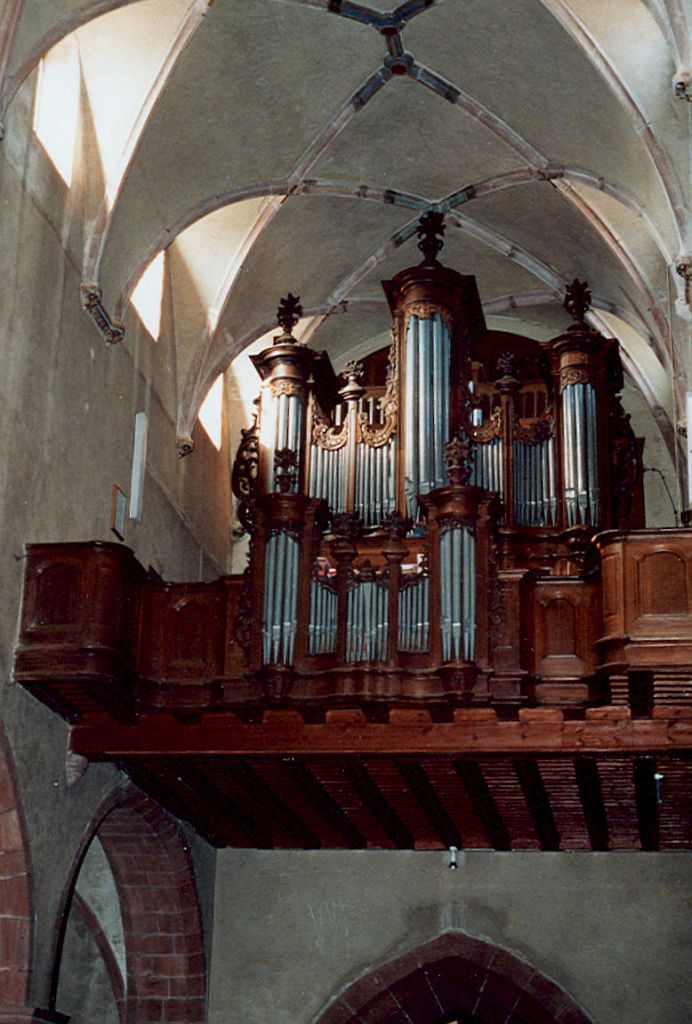Complete description of the selected organ

Photo: Giel Daems
Ammerschwihr, France (Haut-Rhin (68)) - Église Saint-Martin
Municipal: Ammerschwihr
Region:Alsace
Address: Place de l'Abbé Ignace Simonis, 68770, Ammerschwihr
Description nr.: 2020951.
Built by: Martin Rinckenbach (1912)
The organ contains older material: Organ case from 1762 by Louis Dubois
Technical data
Specification
Grand Orgue (C-g'''): Bourdon 16', Montre 8', Bourdon 8', Flûte Majeure 8', Viole de Gambe 8', Dulciane 8', Octavin 4', Flûte à Cheminée 4', Doublette 2', Cornet 5 rangs (c'-g'''), Mixture 5 rangs, Trompette 8', Clairon 4'.
Positif Expressif (C-g'''): Montre 8', Quintaton 8', Cor de Nuit 8', Flûte à Cheminée 8', Salicional 8', Unda Maris 8', Prestant 4', Nasard 2 2/3', Quarte de Nasard 2', Tierce 1 3/5', Cymbale-Tierce 3 rangs, Clarinette 8', Trémolo.
Récit Expressif (C-g'''): Quintaton 16', Diapason 8', Cor de Nuit 8', Flûte Traversière 8', Viole 8', Voix Céleste 8' (c°-g'''), Flûte Octaviante 4', Octavin 2', Plein-Jeu 2-5 rangs, Basson 16', Trompette 8', Voix Humaine 8', Basson/Hautbois 8', Clairon 4', Trémolo.
Pédale (C-f'): Contrebasse 16', Violon 16', Soubasse 16', Bourdon 16', Violoncelle 8', Quinte 5 1/3', Basse 4', Bombarde 16'.
Couplers: Accouplement du Positif au Grand Orgue (16', 8', 4'), Accouplement du Récit au Grand Orgue (16', 8', 4'), Accouplement du Récit au Positif (16', 8', 4'), Tirasse Grand Orgue, Tirasse Positif, Tirasse Récit (8', 4'), Accouplement Général.
Accessories: 1 Combinaison Libre, 7 Combinaisons Fixes (pp - p - mf - f - ff - plein-jeu - grand-jeu), Pédale automatique, Appel Anches, Appel Mixtures, Annulation 16-pieds.

Photo: Giel Daems
Ammerschwihr, France (Haut-Rhin (68)) - Église Saint-Martin
Municipal: Ammerschwihr
Region:Alsace
Address: Place de l'Abbé Ignace Simonis, 68770, Ammerschwihr
Description nr.: 2020951.
Built by: Martin Rinckenbach (1912)
The organ contains older material: Organ case from 1762 by Louis Dubois
| Year | Builder | Opus | Activity | 1762 | Louis Dubois | new organ | 1912 | Martin Rinckenbach | new organ in old case | 1947 | Etablissements E.-A. Roethinger | rebuild | 1981 | Laurent et Chrétien Steinmetz | restoration | 2016 | Ernest Muhleisen | restoration |
- In 1758-1762 Louis Dubois built a three-manual organ for the church of Ammerschwihr. It replaced an organ from 1619, which was built by an unknown maker from Freiburg. The Dubois organ has not been preserved except for the beautiful organ case. In 1912 Martin and Joseph Rinckenbach placed a new pneumatic work with 44 stops in the old cases. The prospect pipes were removed in 1917. In 1947 Roethinger electrified the action. The organ was restored by Laurent Steinmetz in the years 1977-1981.
- A new restoration was carried out in 2015-2016 by the company Ernest Muhleisen.
Technical data
| Number of stops per division | |
| - Grand Orgue | 13 |
| - Positif | 12 |
| - Récit | 14 |
| - Pédale | 8 |
| Total number of stops | 47 |
| Key action | Electropneumatic |
| Stop action | Electropneumatic |
| Windchest(s) | Cone chests |
Specification
Grand Orgue (C-g'''): Bourdon 16', Montre 8', Bourdon 8', Flûte Majeure 8', Viole de Gambe 8', Dulciane 8', Octavin 4', Flûte à Cheminée 4', Doublette 2', Cornet 5 rangs (c'-g'''), Mixture 5 rangs, Trompette 8', Clairon 4'.
Positif Expressif (C-g'''): Montre 8', Quintaton 8', Cor de Nuit 8', Flûte à Cheminée 8', Salicional 8', Unda Maris 8', Prestant 4', Nasard 2 2/3', Quarte de Nasard 2', Tierce 1 3/5', Cymbale-Tierce 3 rangs, Clarinette 8', Trémolo.
Récit Expressif (C-g'''): Quintaton 16', Diapason 8', Cor de Nuit 8', Flûte Traversière 8', Viole 8', Voix Céleste 8' (c°-g'''), Flûte Octaviante 4', Octavin 2', Plein-Jeu 2-5 rangs, Basson 16', Trompette 8', Voix Humaine 8', Basson/Hautbois 8', Clairon 4', Trémolo.
Pédale (C-f'): Contrebasse 16', Violon 16', Soubasse 16', Bourdon 16', Violoncelle 8', Quinte 5 1/3', Basse 4', Bombarde 16'.
Couplers: Accouplement du Positif au Grand Orgue (16', 8', 4'), Accouplement du Récit au Grand Orgue (16', 8', 4'), Accouplement du Récit au Positif (16', 8', 4'), Tirasse Grand Orgue, Tirasse Positif, Tirasse Récit (8', 4'), Accouplement Général.
Accessories: 1 Combinaison Libre, 7 Combinaisons Fixes (pp - p - mf - f - ff - plein-jeu - grand-jeu), Pédale automatique, Appel Anches, Appel Mixtures, Annulation 16-pieds.
| Other specifications | |
|---|---|
| Different specifications |
|
| Literature |
|
| Recordings |
Orgels in de Elzas 1800-1914 / Diverse organisten. - KRO KK CD 9102-9105 (4 CD-box). - 1991. |
| Links |
http://orguesfrance.com/AmmerschwihrStMartin.html |
